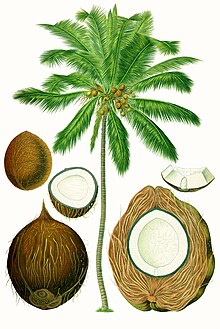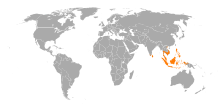**1. Botanical Characteristics and Varieties:**
– Coconut palm trees can grow up to 30 meters tall with pinnate leaves.
– The coconut fruit is a drupe with three layers: exocarp, mesocarp, and endocarp.
– Different varieties like Maypan, King, and Macapuno have varying characteristics.
– Coconuts can be divided into ancestral and domesticated forms, each with distinct traits.
– Dwarf coconut cultivars are fully domesticated and self-pollinating.
**2. Cultural Significance and Distribution:**
– Coconuts hold cultural and religious importance in various societies.
– Indonesia, India, and the Philippines produced about 73% of the world’s coconuts in 2022.
– Coconuts were introduced to different regions by various seafaring cultures.
– Austronesian peoples first domesticated coconuts in Island Southeast Asia.
– Coconuts have a global distribution due to human cultivation and dispersal.
**3. Origin, Domestication, and Dispersal:**
– Modern genetic studies identify the Central Indo-Pacific as the center of origin for coconuts.
– Coconuts played a critical role in the migrations of Austronesian peoples.
– Coconuts are light, buoyant, and water-resistant for long-distance dispersal.
– Dwarf and tall coconut varieties diverged 2 to 8 million years ago.
– Austronesian voyagers likely carried coconuts across the Pacific.
**4. Growth and Cultivation:**
– Coconut palms prefer sandy soils, warm, humid conditions, and full sunlight.
– Trees can yield up to 75 fruits per year, with peak production at 15 to 20 years.
– Propagation is typically done through seed germination or vegetative methods.
– Coconuts take 5-6 years to mature and can produce fruit for up to 80 years.
– Coconut palms are grown in over 90 countries worldwide.
**5. Uses and Ecology:**
– Coconuts provide food, water, oil, and materials for various products.
– Measures like quarantines and pesticides are used to protect coconut production.
– Coconut oil is used in cooking, cosmetics, and biofuels.
– Coconuts are susceptible to lethal yellowing disease, which the Maypan cultivar is resistant to.
– Coir from coconut husks is used for ropes, mats, and soil enrichment.
The coconut tree (Cocos nucifera) is a member of the palm tree family (Arecaceae) and the only living species of the genus Cocos. The term "coconut" (or the archaic "cocoanut") can refer to the whole coconut palm, the seed, or the fruit, which botanically is a drupe, not a nut. They are ubiquitous in coastal tropical regions and are a cultural icon of the tropics.
| Coconut Temporal range: Early Eocene – Recent
| |
|---|---|

| |

| |
| Scientific classification | |
| Kingdom: | Plantae |
| Clade: | Tracheophytes |
| Clade: | Angiosperms |
| Clade: | Monocots |
| Clade: | Commelinids |
| Order: | Arecales |
| Family: | Arecaceae |
| Subfamily: | Arecoideae |
| Tribe: | Cocoseae |
| Genus: | Cocos L. |
| Species: | C. nucifera
|
| Binomial name | |
| Cocos nucifera L.
| |

| |
| Possible native range prior to domestication | |
| Synonyms | |
| |
The coconut tree provides food, fuel, cosmetics, folk medicine and building materials, among many other uses. The inner flesh of the mature seed, as well as the coconut milk extracted from it, form a regular part of the diets of many people in the tropics and subtropics. Coconuts are distinct from other fruits because their endosperm contains a large quantity of clear liquid, called "coconut water" or "coconut juice". Mature, ripe coconuts can be used as edible seeds, or processed for oil and plant milk from the flesh, charcoal from the hard shell, and coir from the fibrous husk. Dried coconut flesh is called copra, and the oil and milk derived from it are commonly used in cooking – frying in particular – as well as in soaps and cosmetics. Sweet coconut sap can be made into drinks or fermented into palm wine or coconut vinegar. The hard shells, fibrous husks and long pinnate leaves can be used as material to make a variety of products for furnishing and decoration.
The coconut has cultural and religious significance in certain societies, particularly in the Austronesian cultures of the Western Pacific where it features in their mythologies, songs, and oral traditions. The fall of its mature fruit has led to a preoccupation with death by coconut. It also had ceremonial importance in pre-colonial animistic religions. It has also acquired religious significance in South Asian cultures, where it is used in rituals of Hinduism. It forms the basis of wedding and worship rituals in Hinduism. It also plays a central role in the Coconut Religion founded in 1963 in Vietnam.
Coconuts were first domesticated by the Austronesian peoples in Island Southeast Asia and were spread during the Neolithic via their seaborne migrations as far east as the Pacific Islands, and as far west as Madagascar and the Comoros. They played a critical role in the long sea voyages of Austronesians by providing a portable source of food and water, as well as providing building materials for Austronesian outrigger boats. Coconuts were also later spread in historic times along the coasts of the Indian and Atlantic Oceans by South Asian, Arab, and European sailors. Based on these separate introductions, coconut populations can still be divided into Pacific coconuts and Indo-Atlantic coconuts, respectively. Coconuts were introduced by Europeans to the Americas during the colonial era in the Columbian exchange, but there is evidence of a possible pre-Columbian introduction of Pacific coconuts to Panama by Austronesian sailors. The evolutionary origin of the coconut is under dispute, with theories stating that it may have evolved in Asia, South America, or Pacific islands.
Trees grow up to 30 metres (100 feet) tall and can yield up to 75 fruits per year, though fewer than 30 is more typical. Plants are intolerant to cold and prefer copious precipitation and full sunlight. Many insect pests and diseases affect the species and are a nuisance for commercial production. In 2022, about 73% of the world's supply of coconuts was produced by Indonesia, India, and the Philippines.
